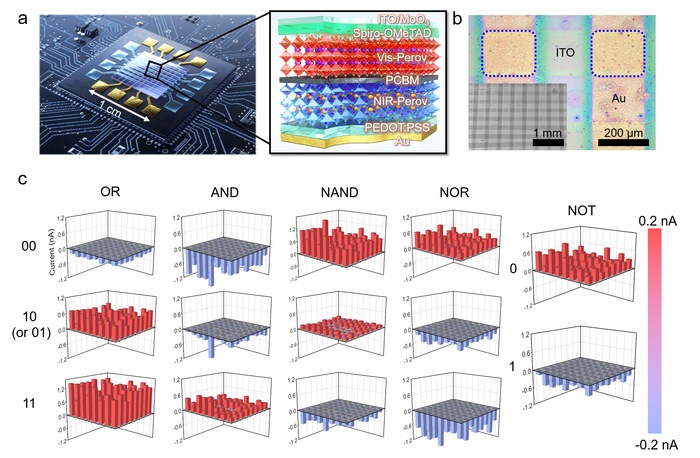Reviewed by Alex SmithMay 3 2022
Artificial intelligence, self-driving vehicles, drones and metaverse technologies are gaining traction as core sectors of the future, and demand for computers that can swiftly calculate and analyze enormous volumes of data is skyrocketing.
 Three-dimensional bar charts for all the outputs (“OR”, “AND”, “NAND”, “NOR”, and “NOT”) obtained from the 64 pixels. The red and blue bars show clear bipolar spectral photoresponses of all the pixels with reference to the fiducial level of 0 nA (gray face). Image Credit: Korea Institute of Science and Technology (KIST).
Three-dimensional bar charts for all the outputs (“OR”, “AND”, “NAND”, “NOR”, and “NOT”) obtained from the 64 pixels. The red and blue bars show clear bipolar spectral photoresponses of all the pixels with reference to the fiducial level of 0 nA (gray face). Image Credit: Korea Institute of Science and Technology (KIST).
Electronic semiconductor logic gates, currently serving as the brains of computers, have limited capabilities in high-speed data computation and processing and have drawbacks such as excessive energy consumption and heat generation.
Korea Institute of Science and Technology (KIST, President: Seok-Jin Yoon) and Gwangju Institute of Science and Technology (GIST, President: Ki-Seon Kim) announced that their research teams, headed by Dr. Yusin Pak at the Sensor System Research Center (KIST) and Professor Gun Young Jung at the School of Materials Science and Engineering (GIST), have designed ultra-high-speed, super-efficient optoelectronic logic gates (OELGs) utilizing organic-inorganic perovskite photodiodes.
The optoelectronic logic gate is a high-speed, high-efficiency device that employs light as an input signal, resulting in low energy loss and the ability to function with only light energy without consuming electricity. A layered perovskite optoelectronic logic gate was created by the research teams.
Two layers of perovskite thin films are placed vertically like a sandwich to demonstrate that the required binary logic operation can be achieved by combining two distinct wavelengths and intensities of light.
Since the perovskite optoelectronic logic gate can easily modify the photocurrent polarity using light, it is possible to execute several logic gate operation results for the same input value.
As a result, unlike the current logic gate — which conducts one logical operation on a single device, the newly designed one can implement all five fundamental logic operations, including AND, OR, NAND, NOR and NOT.
It allows for the creation of optical processors with excellent spatial efficiency and integration since one logic gate can perform the functions of five logic gates.
Perovskite optoelectronic logic gates that execute multiple logic operations in response to optical input are expected to be used for ultra-small and low-power universal optical sensor platforms in the future.
Dr. Yusin Pak, Sensor System Research Center, Korea Institute of Science and Technology
The optoelectronic logic gate developed through this research is an outcome of optical computing R&D that realizes five basic logic operations into one device, and will greatly contribute to next-generation optical communication, optical network, and healthcare R&D.
Professor Gun Young Jung, School of Materials Science and Engineering, Gwangju Institute of Science and Technology
Journal Reference:
Kim, W., et al. (2022) Perovskite multifunctional logic gates via bipolar photoresponse of single photodetector Nature Communications doi.org/10.1038/s41467-022-28374-w.